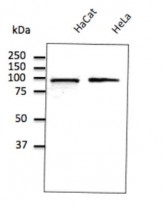ARG55732
anti-Calnexin antibody
anti-Calnexin antibody for ICC/IF,IHC-Frozen sections,IHC-Formalin-fixed paraffin-embedded sections,Western blot and Human,Mouse,Rat,Dog,Monkey
Overview
| Product Description | Goat Polyclonal antibody recognizes Calnexin |
|---|---|
| Tested Reactivity | Hu, Ms, Rat, Dog, Mk |
| Tested Application | ICC/IF, IHC-Fr, IHC-P, WB |
| Specificity | Detects a band of 90 kDa by Western blot in the following human (293A, primary fibroblasts, HaCat, HeLa, HMEC-1, Jurkat, MNT1, U-118, rat (TR-iBRB), mouse (3T3, AtT-20, Hepa, Raw264.7), monkey (COS-7) and canine (D17) whole cell lysates. |
| Host | Goat |
| Clonality | Polyclonal |
| Isotype | IgG |
| Target Name | Calnexin |
| Antigen Species | Human |
| Immunogen | Purified recombinant peptide around aa. 550 (C-terminus) of Human CANX |
| Conjugation | Un-conjugated |
| Alternate Names | P90; CNX; p90; Major histocompatibility complex class I antigen-binding protein p88; Calnexin; IP90 |
Application Instructions
| Application Suggestion |
|
||||||||||
|---|---|---|---|---|---|---|---|---|---|---|---|
| Application Note | * The dilutions indicate recommended starting dilutions and the optimal dilutions or concentrations should be determined by the scientist. |
Properties
| Form | Liquid |
|---|---|
| Purification | Affinity purification with immunogen. |
| Buffer | PBS, 0.05% Sodium azide and 20% Glycerol |
| Preservative | 0.05% Sodium azide |
| Stabilizer | 20% Glycerol |
| Concentration | 2 mg/ml |
| Storage Instruction | For continuous use, store undiluted antibody at 2-8°C for up to a week. For long-term storage, aliquot and store at -20°C. Storage in frost free freezers is not recommended. Avoid repeated freeze/thaw cycles. Suggest spin the vial prior to opening. The antibody solution should be gently mixed before use. |
| Note | For laboratory research only, not for drug, diagnostic or other use. |
Bioinformation
| Database Links | |
|---|---|
| Gene Symbol | CANX |
| Gene Full Name | calnexin |
| Background | This gene encodes a member of the calnexin family of molecular chaperones. The encoded protein is a calcium-binding, endoplasmic reticulum (ER)-associated protein that interacts transiently with newly synthesized N-linked glycoproteins, facilitating protein folding and assembly. It may also play a central role in the quality control of protein folding by retaining incorrectly folded protein subunits within the ER for degradation. Alternatively spliced transcript variants encoding the same protein have been described. [provided by RefSeq, Jul 2008] |
| Function | Calcium-binding protein that interacts with newly synthesized glycoproteins in the endoplasmic reticulum. It may act in assisting protein assembly and/or in the retention within the ER of unassembled protein subunits. It seems to play a major role in the quality control apparatus of the ER by the retention of incorrectly folded proteins. Associated with partial T-cell antigen receptor complexes that escape the ER of immature thymocytes, it may function as a signaling complex regulating thymocyte maturation. Additionally it may play a role in receptor-mediated endocytosis at the synapse. [UniProt] |
| Calculated MW | 68 kDa |
| PTM | Phosphorylated at Ser-564 by MAPK3/ERK1. phosphorylation by MAPK3/ERK1 increases its association with ribosomes (By similarity). Palmitoylation by DHHC6 leads to the preferential localization to the perinuclear rough ER. It mediates the association of calnexin with the ribosome-translocon complex (RTC) which is required for efficient folding of glycosylated proteins. Ubiquitinated, leading to proteasomal degradation. Probably ubiquitinated by ZNRF4. |
Images (2) Click the Picture to Zoom In
-
ARG55732 anti-Calnexin antibody WB image
Western blot: 50 µg of HaCat and HeLa cell lysates stained with ARG55732 anti-Calnexin antibody at 1:500 dilution.
-
ARG55732 anti-Calnexin antibody ICC/IF image
Immunocytochemistry: Hepa1-6 cells stained with ARG55732 anti-Calnexin antibody at 1:100 dilution. Cells were fixed with 4% of PFA.







